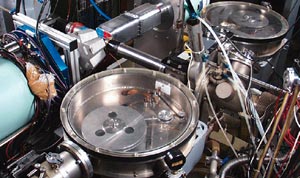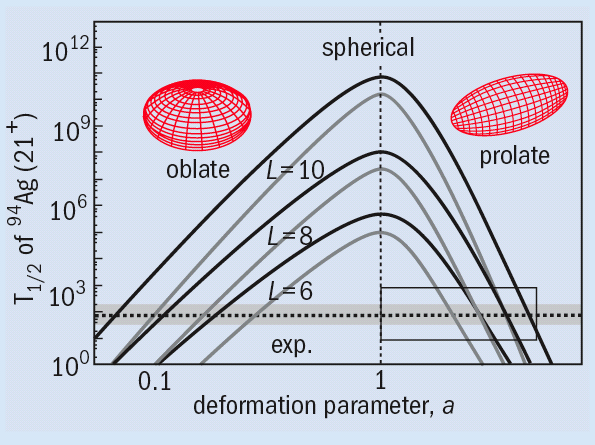Since soon after its discovery by Henri Becquerel in 1896, radioactivity has been known to involve the emission of helium nuclei (alphas), electrons (betas) and photons (gammas). Then, in 1960, proton-rich nuclei with an odd or an even atomic number Z were predicted to decay through one- and two-proton radioactivity, respectively. Single-proton radioactivity was discovered in 1981, while the first evidence for two-proton radioactivity was obtained in 2002 in the decay of 45Fe.

Now in an experiment on 94Ag, an international team lead by Ivan Mukha and Ernst Roeckl has made the first experimental observation of nuclear decay involving both one- and two-proton radioactivity (Mukha et al 2006). The researchers attribute the two-proton emission behaviour and the unexpectedly large probability for this decay mechanism to a very large deformation of the parent nucleus into a prolate (cigar-like) shape, which facilitates emission of protons either from the same or from opposite ends of the “cigar”.

Working at the GSI research centre, the researchers synthesized the lightest known isotopes of silver (94Ag) using nuclear reactions between accelerated 40Ca ions and 58Ni atoms. After purification by online mass separation the 94Ag nuclei were implanted into a catcher positioned in a highly segmented array of silicon and germanium detectors. The simultaneous two-proton emission was identified from a long-lived (0.4 s), high-spin state of 94Ag. This (21+) isomer is also known to undergo one-proton decay (Mukha et al 2005).
Both disintegration modes were unambiguously identified by “tagging” γ rays that are known to de-excite the high-spin states populated in the daughter nuclei 93Pd and 92Rh for one-proton and two-proton decay, respectively. In particular, the team searched for direct two-proton decay of the isomer by measuring coincidences between double-hit events recorded by the silicon detectors and γ-γ events registered by the germanium detectors. The observed two-proton decay is unexpectedly fast.
This first measurement of correlation data in two-proton radioactivity calls for further experimental studies of the properties of this truly exotic isomer. It also demands a more quantitative theoretical description of the observed two-proton decay behaviour.
Further reading
I Mukha et al 2006 Nature 439 298.
I Mukha et al 2005 Phys. Rev. Lett. 95 022501.








